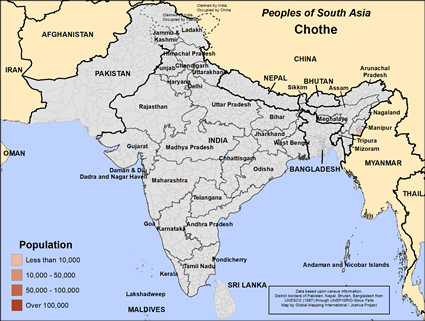Chothe in India

Photo Source:
Ramesh Lalwani - Flickr
Creative Commons
|

Map Source:
People Group data: Omid. Map geography: UNESCO / GMI. Map Design: Joshua Project
|
| People Name: | Chothe |
| Country: | India |
| 10/40 Window: | Yes |
| Population: | 3,800 |
| World Population: | 3,800 |
| Primary Language: | Naga, Chothe |
| Primary Religion: | Christianity |
| Christian Adherents: | 97.35 % |
| Evangelicals: | 0.00 % |
| Scripture: | New Testament |
| Ministry Resources: | Yes |
| Jesus Film: | No |
| Audio Recordings: | No |
| People Cluster: | South Asia Tribal - Naga |
| Affinity Bloc: | South Asian Peoples |
| Progress Level: |
|
Introduction / History
The Chothe is a small tribal community are found in the northeastern Indian state of Manipur. Almost Chothe claim to be followers of Jesus Christ. They speak their own language of Nag Chothe. The New Testament became available to the Chothe in 2014. Many of the Chothe still need to learn to read and write.
What Are Their Lives Like?
A system of self-administration tradition has always been a part of Chothe history. Chothe villages form an executive body to administer themselves. Often an opposition group will also be formed to help scrutinize the functioning of the governing body of the village. Whenever a new Chothe village is established, its leaders are elected through competitions participated in by the representatives of each clan of the tribe. Then the posts are distributed according to the merits of the competitors. Present day Chothe have shunned many ancient customs and traditions except the system of self-administration and marriage customs. They embraced Christianity 60 years ago through the work of missionaries. They no longer maintain their ancient weapons, tools and dress. The men make baskets of bamboos and the womenfolk collect firewood from the jungles and then sell their products at the nearest market to meet their daily needs. They practice cultivation and other agricultural work, but most of the rice paddy fields are owned by other communities. Poverty is rampant in the Chothe society. They cannot afford education for their children, nor can they afford healthy food and decent clothing. High school graduates are rare, and the government schools established near their villages are not functioning anymore since there are no teachers. The Chothe have no modern health centers near their villages. As a result many Chothe have died from preventable causes. Though most of the Chothe villages are situated a few miles from towns and accessible by roads, they still live without electricity and proper sanitation system. The Chothe have a unique system of rules regarding who can marry whom. Among the Chothes there are bride-giver clans and bride takers clans. If a young man wants to marry, he has to take his bride from those clans whose women he was meant to marry. However, in the present generation, there are many who are breaking these traditional marriage rules. They are fined by the elders and the village authorities in the form of material and money. Because of the traditional marriage rules, many young couples prefer to elope. So, traditional marriages and ceremonies are becoming rare in Chothe society.
What Are Their Beliefs?
Most Chothe are now Christian in name only. However, their main religion is animism. They consult wizards and black-magicians of other communities to sort out their problems and cure their illnesses. Before the advent of Christianity, they are recorded to have worshipped Hindu deities. Hinduism came to Manipur only in the early 18th century.
What Are Their Needs?
What the Chothe need are Christian workers who can help unite them to Christ. They need salvation from the evil spirits of folk religion. Tribalism can be interpreted as a larger group harassing the weaker tribe. The Chothe need job and literacy skills. They need access to modern medicine, electricity and clean water.
Prayer Points
Pray for the work of the Holy Spirit to transform the Chothe families and communities. Ask the Lord to provide trained pastors to teach the Chothe the Bible. Pray for good schools and teachers for the Chothe to prepare them for higher education. Pray also for proper sanitation systems and new jobs training.